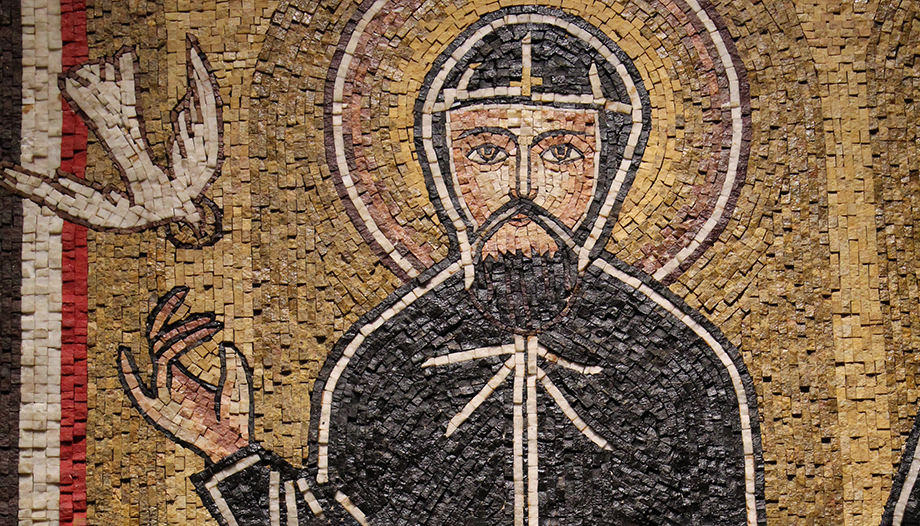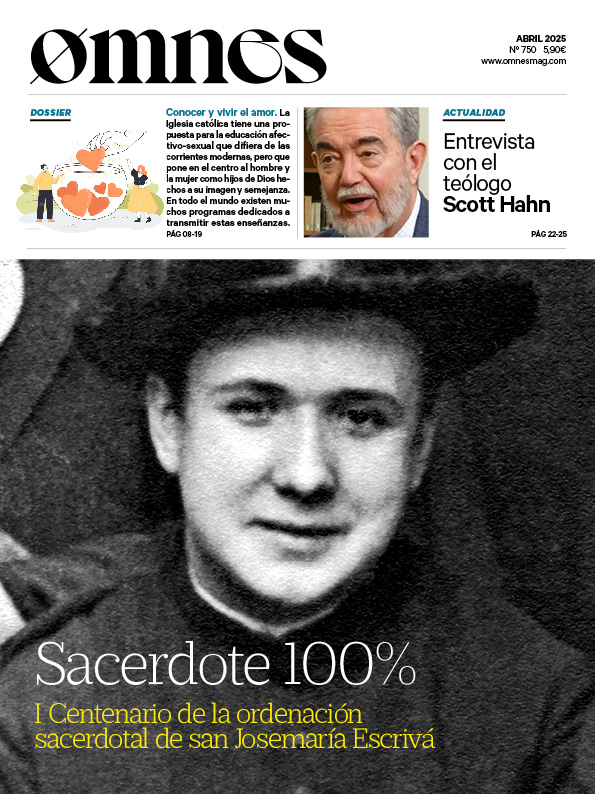In the Maronite liturgy, singing in prayer is a way of caressing God our Lord; it is a tender and sweet way to address Him with melodies that express human feeling from Tradition and the Holy Scriptures. It does not have the western criteria of rationalization of music, but tends to be affective (heart), with a poetic language and, in many ways, improvisation.
Syro-Antiochean and monastic chanting
The Maronite chant is a Syro-Antiochean chant (Syriac of Antioch) and of monastic character. These are the two fundamental elements that delimit its identity.
The fact that it is a Syro-Antiochene chant is due to the fact that the Maronite Church - one of the 24 churches sui iuris of the Catholic Church; the Church sui iuris The most widespread is the Latin Church - it belongs to the Syriac liturgical tradition of Antioch - the first Petrine See - and therefore its traditional chants are in Aramaic (Syriac) and Semitic.
It should be noted that among the various repertoires of the different branches of the Syro-Antiochene Churches, the musical affinity is different among the groups and strata that constitute the repertoires of each Syriac Antiochene Church. The Syriac Antiochene Maronite chant preserves its own originality and peculiarity with respect to the rest of the chants of the other Syriac Churches (both Syriac Catholic and Syriac Orthodox).
The birth of three rites
The Church of Antioch, beginning in the 5th century - because of the Christological discussions of the time - gradually gave rise to three independent rites: the Eastern Syro-Antiochene rite (followed by the Assyrian, Chaldean and Malabar Churches); the non-Chalcedonian Western Syro-Antiochene rite (followed by the Syriac and Malankar Churches); and the Chalcedonian Western Syro-Antiochene rite (followed only by the Maronite Church, all Catholic and without an Orthodox branch). The Maronite Church, because of its unity and fidelity to the Pope of Rome, gradually isolated itself from the rest of the Antiochian Syriac Churches until it constituted its own patriarchal hierarchy from the 7th century with St. John Maron as the only Eastern Church united to Rome while preserving the succession of St. Peter in Antioch.
The language used in Syro-Antiochene Maronite chant is Aramaic in its Syriac dialect (a language developed in the region of Edessa) and, although its origin goes back to the 1st century, its manuscript testimonies are found from the 2nd-3rd century onwards; for example, in the hymns of Bardaisan (+222), of Ephrem the Syriac (+373), of Balai (+ ca. 432), of Narsai (+502) or of James of Serugh (+521).
In the 13th century, a bull of Pope Innocent III in 1215 asked the Maronites to adopt certain Roman customs, for which the Maronite Church had a period of Latinization in its liturgy that, paradoxically, did not affect its chant, since the chant, being the prayer of the heart of the Maronite people and being part of its identity, allowed to preserve, until today, both its liturgical language (Aramaic) and its original melodies. Moreover, from that century onwards, the written history of Maronite chanting remained silent, as only the manuscript of the Office of the Dead was preserved (Syriac Vatican Manuscript 59), and a few commentaries on Syriac music by the Jacobite bishop Gregory Bar Hebræus (+ 1286).
This allows us to affirm that Maronite chant was kept alive only orally until practically the 19th century, when Father Jean Parison recorded in 1899 the first musical annotation in a scientific study on the Syriac language and music of the Maronite, Chaldean and Syriac rites. Since then, scores and writings on Maronite music began to be written, such as those by Brother Marie-André Chaptini (1924), Father Boulos Ashqar (1939), Yaacoub Fayyad (1947), Father Youssef Khoury (1992), Father Louis Hage (1976), Father Miled Tarabay (1998) or Sister Marana Saad (2010), to mention a few.
The monastic character of the Maronite chant is due to its origin. It was the monastery of Beth Maron (monastery of St. Maron), founded around 452 in Apamea on the banks of the Orontes River, where the monks of Antioch lived and carried out their liturgical and spiritual life. The whole day was a song of praise to God our Lord; they did not cease to sing day and night. They did it in turns and the lay people came to sing with them, as their occupations permitted, to join in prayer. So fervent was the spiritual life of the region that the life of the people and their unity with their monks revolved around the monastery. This allowed music to be preserved as an integral part of society from childhood and in the family. In addition, it served as a method of catechesis, since the lyrics of the songs, full of doctrine, contained the teaching of the Christian faith and love for the Virgin Mother of God.
Maronite chant: a poem in melody
The melodies consist of a base of improvised melody, that is, the texts written in prose are sung with a process of improvisation that does not have clear instructions for its execution or interpretation, and in this way the prose becomes, when sung, a kind of poetry.
However, the rest of the non-prose chants are poetic, that is, the Maronite chant is poetry written in Aramaic (Syriac). The poetry is strophic and each stanza assumes the same or similar construction, where the poetic meter and the strophic model are taken into account, and each chant has its name.
Maronite chant consists of two poetic metrical models: metric by quantity and metric by number of syllables. The poetic metric by quantity takes into account the long and short character of the syllables in verse. Poetic metrics by number of syllables is divided into two categories: homothony, where the stressed syllables of a line are counted without considering the total number of syllables; and isosyllabic, where all the syllables of the line are counted, regardless of their stressed or atonic character.
Maronite chant strophic pattern
The basic strophic model is known as the rish qolo -Aramaic phrase that in English means "head of the hymn"-, and is considered as the reference point to reproduce it throughout the song. The function of the rish qolo is both to indicate the versification or poetic structure of the stanzas, and to indicate the melody linked to the strophic model. The Maronite chants are organized by names, i.e., the names of the rish qolo of the strophic models bear a proper name that indicates either the meter of the poem, the liturgical function, the archetype of the hymn or the way of performing them. To these names can be added some subtitle indicating the place of the liturgical office in which it is sung, the first words of the original poem or the word of the preceding chant to know the sequence.
To better explain this organization by name of the rish qolothe following examples of strophic model names of some Maronite songs are presented: el ramremain -meaning "we exalt" in Aramaic-, is a strophic model of liturgical function that serves to introduce the readings. bo'uto dmor efremmeans "Supplication of St. Ephrem", is a name that refers to the metric of 7+7 syllables. sedro -meaning "line" in Aramaic-, is a name indicating the structure of a type of liturgical prayer, the qole yawnoye -meaning "Greek hymn" in Aramaic-, is a name that points to the archetype of the hymn, the lhudoye -meaning "loners" in Aramaic-, which indicates the way to execute it; etc.
Among the subtitles that can be used as examples are: the mazmuro -meaning "psalm" in Aramaic-, which indicates a type of psalmody for the liturgical office. tubayk 'idto -meaning "blessed are you, O Church" in Aramaic-, which are the first words of the melody; the korozuto -means "proclamation" in Aramaic-, which marks the sequence within the liturgy.
Poetic categories (or melodies)
With the poetic categories (or melodies) of Maronite chant, the types of use given to the chant are classified. However, this poetic categorization is not always easy to distinguish, since the difference does not lie only in the metric or in a specific and well-defined attribute, but may be due to the meaning of the text or to its liturgical use or to the strophic models or to the set of several characteristics.
Among the poetic categories, the following are mentioned, by way of example and without being the only ones, the following: the madrosho -meaning "instruction" in Aramaic-, is an ancient lyrical genre in the pedagogical style and serves to instruct in the faith. sughito -meaning "ode" in Aramaic-, is a popular lyric genre that is sung in dialogical form with a dramatic character, often with acrostic stanzas. bo'uto -meaning "supplication" in Aramaic-, is a lyrical genre that designates a poetic composition in the form of stanzas with a well-defined meter. mimro - meaning "metrical homily" in Aramaic, is a lyrical genre of sung homilies; ulito -meaning "lamentation" in Aramaic-, is a lyrical genre concerning specific liturgical functions or circumstances, such as those sung at funerals. qolo -meaning "voice" in Aramaic-, is a lyrical genre of a sung hymn; etc.
It is important to note that when Syriac melodies are sung, alternate versions of the same melody with other lyrics are used. That is, it is the same melody, but the lyrics vary. For example, in a bo'uto dmor yacoub -means "supplication of James" in Aramaic, and it is a bo'uto whose metric is 4+4+4 syllables - is sung in the liturgical cycle of Epiphany with lyrics about the baptism of the Lord, but in the liturgical cycle of the Resurrection it is sung with lyrics referring to Easter, etc.
All poetic categories are usually sung alternately in two choruses (one stanza is sung by one group and the other by the other group).
Characteristics of Maronite chant
The Maronite Syriac chant, being an ancient, traditional, liturgical and communitarian chant of the Maronite Church, is found in the liturgical texts from an early date, and it gradually took shape with a style of its own that distinguished it, as already mentioned, from the chants of other Syriac liturgical traditions; And it has come down to us practically by oral tradition, for, as noted above, it was written very little and yet it has been very much unaltered, so that it has been preserved with its peculiar originality up to the present day.
In terms of expression, the melody has almost no relation to the text, since the text has too many stanzas and the melody has too few notes.
In terms of meter, the melody usually embraces the structure of the verse and its meter. It presents a great affinity both with the ancient sacred chant of the Syro-Antiochan churches and with the profane, popular and traditional chants of the Middle Eastern countries.
Maronite Syriac chant is syllabic, that is, each syllable carries one note, with the exception of the last syllable, and sometimes the penultimate syllable, which carry several notes.
Being a tonal music, both the mode (the different disposition of the intervals of the scale) and the scale itself (the diatonic succession of the notes) could not be distinguished, but they are two very different aspects. As for the scale of the Maronite chant, for the mode, one can follow the criterion of a tempered diatonic scale of equal semitones, or that of an oriental scale of the 24 equal "quarter tones", or that of a compatibility of the diatonic scale and the non-diatonic scale. But do not forget that the scale of Maronite chant was originally untempered.
The interval of a major, minor or neutral second is by far the most commonly used interval in Maronite music. The pitch, ascending or descending, may be "perfect" or diminished; the semitone may be diatonic or slightly raised.
The range is very limited; in most cases it is limited to three, four or five notes. More than five notes is very rare. By sometimes adding a note to the high note or the low note, the ranges reach a minor sixth.
There are various processes of melodic movement in Maronite music, although the most common one begins with the tonic in B (B), that is, with the first note of a musical scale. Melodies ending in C (C) may ordinarily begin with a C (C), E (E), F (F) or G (G). Those ending in re (D) ordinarily begin with a re (D), a fa (F) or a sol (G), and exceptionally with an mi (E), an la (A) or a do (C). And the melodies that end in mi (E) ordinarily begin with an mi (E) or a sol (G), and exceptionally with a do (C), a re (D) or a fa (F).
The gradual movement of the melody, as well as the frequency of certain principal notes, especially the tonic, facilitate communal singing. These melodies, being composed in this way, emphasize that they are not intended to be performed by a soloist or even by a choir, but are to be sung by the assembly of the faithful. In fact, everyone can participate in the singing of the divine office, for the melodies are simple and easy.
Centonization is the technique most commonly used in Syro-Maronite chant, i.e., it is the composition of melodies from already existing melodic material; thus, the composition of a Maronite piece is an organized centonization of existing and known melodic formulas. These formulas are frequently repeated, sometimes in an orderly fashion and sometimes in a random fashion, but they never appear alone or in a pure state.
The other technique for the composition of Maronite Syriac chant has been that of adaptation, which consists of adapting a new text to an existing melody. Sometimes the adaptation is identical to the original, other times it is adapted to fit better.
The singing is monodic, that is, it has no harmony.
The Syro-Maronite repertoire does not give room to the oktoíjos (musical writing system composed of eight modes) and its equivalents.
For the execution and interpretation of the Maronite Syriac chant it is presupposed and required - and this is absolutely basic and very important - that the assembly prays while singing, for it is a prayer sung to speak with God. The interpretation is based on memory and its historical flavor and not on musical theory or notation, so it springs more from the heart than from reason. Maronite chant is a popular chant (to be sung by the people: monks and laity), simple, repetitive, with about 150 melodies and, always and in everything, a way of praying.
Pastor of the Maronite parish of San Chárbel in Mexico.









